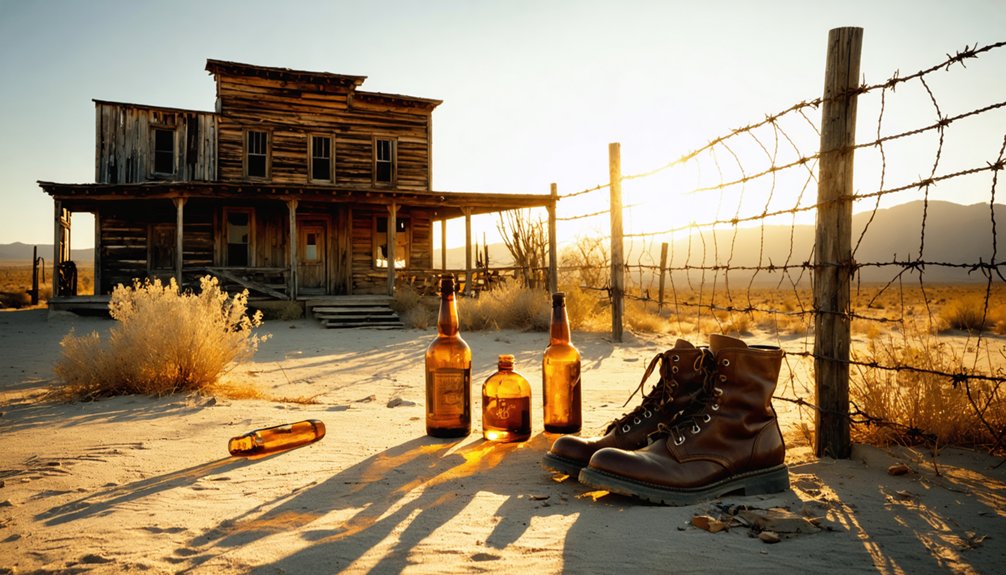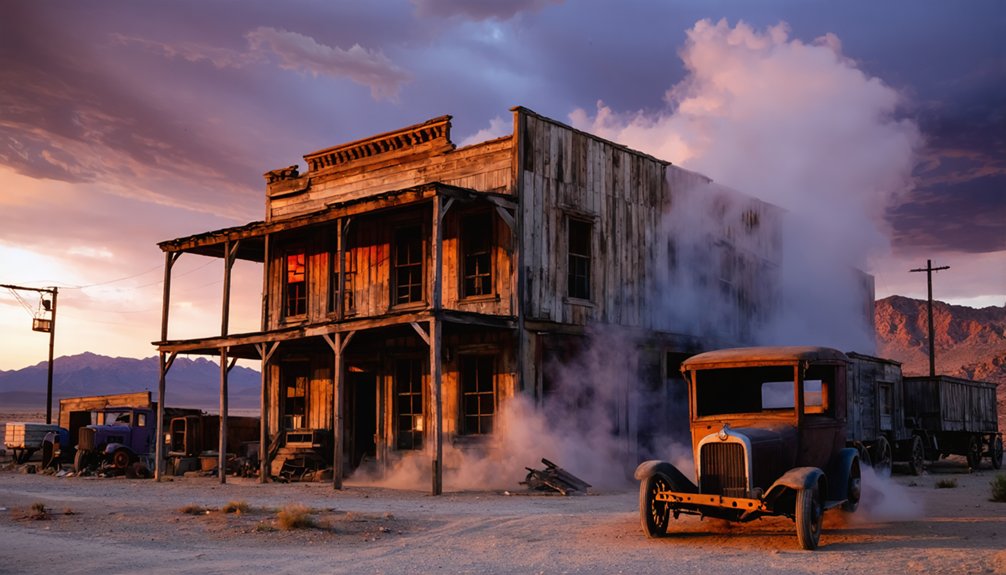Nevada’s abandoned miner homes tell haunting stories of boom-and-bust cycles across the Silver State. You’ll find Tom Kelly’s ingenious Bottle House in Rhyolite, Belmont’s resilient brick chimneys, Ruby City’s decaying three-story bank, Virginia City’s preserved mining mansions, and secret desert shacks showcasing innovative survival techniques. These architectural remnants stand as silent witnesses to prosperity, hardship, and resourcefulness in harsh desert conditions. The weathered structures harbor fascinating tales of those who once sought fortune in Nevada’s mountains.
Key Takeaways
- Tom Kelly’s Bottle House in Rhyolite stands as an ingenious desert dwelling constructed from 50,000 beer and liquor bottles.
- Belmont’s abandoned miner cabins feature distinctive brick chimneys that have withstood harsh desert conditions for over 150 years.
- Ruby City’s three-story bank ruins showcase the dramatic transition from frontier opulence to natural reclamation.
- Virginia City’s preserved mining mansions like Graves Castle and Chollar Mansion represent Nevada’s silver rush prosperity.
- Secret desert shacks in hidden mining camps display innovative survival techniques with corrugated tin structures and communal living spaces.
Tom Kelly’s Bottle House: Rhyolite’s Ingenious Desert Dwelling
In the golden rays of Nevada’s early 1900s mining boom, an architectural marvel emerged from necessity and ingenuity in the Bullfrog Hills.
Tom Kelly, an Australian-born stonemason turned gold miner, crafted what would become Rhyolite’s most enduring landmark—a three-room house constructed from approximately 50,000 beer and liquor bottles.
From humble bottles to architectural legacy, Kelly’s resourceful vision transformed desert waste into Rhyolite’s most enduring treasure.
This exemplar of desert innovation solved a practical challenge; with Joshua trees providing unsuitable lumber, Kelly turned to abundant waste materials.
Using his masonry expertise, he embedded bottles in adobe mud and cement mortar, creating walls that were later plastered inside like conventional homes.
The bottle architecture featured decorative elements like gingerbread trim and bottle quoins at corners.
Local children earned ten cents per wheelbarrow collecting bottles from Rhyolite’s fifty saloons, unknowingly contributing to what remains Nevada’s finest example of bottle construction.
After completion, the house was purchased by the Bennett family who lived in this unique dwelling from 1906 until 1914.
When completed in February 1906, Kelly sold raffle tickets for $5 each to determine the home’s new owner.
The Forgotten Brick Chimneys of Belmont’s Miner Cabins
Standing sentinel across the windswept landscape of Belmont, Nevada, the forgotten brick chimneys of miners’ cabins provide a haunting glimpse into the town’s silver-rich past.
You’ll notice these resilient structures remain upright while wooden frames have collapsed around them—a symbol of their solid construction amid harsh desert conditions.
Established in 1865 during Nevada’s silver rush, Belmont’s chimneys represent critical mining heritage worth preserving. Their varying brick colors and textures reveal locally-sourced materials, each telling a story of regional mineral composition and manufacturing techniques.
Similar to the multiple cabins found around Nevada mining sites, these structures often housed miners who worked in dangerous conditions extracting valuable minerals like cinnabar for mercury.
Though exposed to natural erosion and occasional vandalism, they’ve resisted complete collapse. At an elevation of 7,424 feet, Belmont’s structures have withstood particularly harsh mountain weather conditions while preserving their historical integrity.
Unlike the Monitor-Belmont Mill chimney damaged during WWII target practice, these smaller cabin chimneys persist as unprotected ruins—silent witnesses to the boom-and-bust cycle that defines Nevada’s mining towns.
Ruby City’s Three-Story Bank: From Opulence to Decay
Three grand stories once defined Ruby City’s most ambitious building—a symbol of frontier optimism now reduced to scattered stone remnants.
The bank architecture reflects the ephemeral wealth of Nevada’s 1870s silver boom, where prosperity appeared limitless until economic decline swiftly followed.
When visiting these ruins, you’ll appreciate how they embody the freedom-seeking spirit that defined western expansion:
- The partial stone wall visible today likely belonged to the assayer’s office, where miners’ fortunes were determined
- Unlike the Cook Bank in nearby Rhyolite, Ruby City’s financial institution never achieved marble staircases or mahogany interiors
- Natural reclamation has recaptured most building foundations
- The town’s silver-based economy failed to sustain long-term growth
- These remains stand as silent witnesses to boom-and-bust cycles that shaped Nevada’s development
Fragments of glass bottles and rusted implements can be found throughout the area, providing glimpses into the daily lives of former residents.
In contrast to Ruby City, Rhyolite’s impressive Cook Bank building was constructed for $90,000 and represented the town’s prosperity during its brief golden age.
Virginia City’s Preserved Mining Mansions and Heritage Homes
Virginia City’s preserved mansions stand as architectural monuments to Nevada’s most spectacular mining success story, in stark contrast to Ruby City’s crumbling ruins.
When you walk the streets of this 6,200-foot elevated settlement, you’re treading above vast mining operations that once extended 3,000 feet beneath your feet, generating millions in silver and gold wealth.
The town’s Victorian Architecture flourished rapidly after the 1859 Comstock Lode discovery transformed a makeshift camp into an industrial powerhouse.
Magnificent residences like the Graves Castle Mansion (1868), Chollar Mansion (1862-1864), and Savage Mansion (1861) showcase the Mining Heritage that generated $300 million during the “Big Bonanza” era.
These preserved heritage homes, with their European-imported furnishings and distinctive Italianate styles, represent the unprecedented prosperity that attracted 25,000 residents to this mountain settlement during mining’s golden age.
The legacy of John Mackay, one of the famous Bonanza Kings who emerged from Virginia City’s mining industry, lives on through the town’s preserved historical character.
Despite a devastating fire in the 1870s that caused $10 million in damage to much of the town, many historic buildings from the 1860s were saved or rebuilt, preserving the craftsmanship of the era.
Secret Desert Shacks: Innovative Survival in Nevada’s Hidden Mining Camp
Deep within Nevada’s unforgiving desert landscape, hidden mining camps reveal architectural innovation born of necessity and human ingenuity.
You’ll discover resourcefulness through desert craftsmanship that transformed hostile environments into functional living spaces.
These secret shacks demonstrate remarkable adaptation through:
- Corrugated tin construction providing structural integrity against harsh elements
- Communal living arrangements with bunk beds and shared work spaces
- Repurposed materials—most significantly Tom T. Kelly’s 50,000-bottle house in Rhyolite
- Integration of modern conveniences: concrete sidewalks and indoor plumbing during boom periods
- Strategic placement of outhouses and workshops near living quarters for efficiency
These abandoned dwellings stand as evidence of miners’ resilience, preserving narratives of freedom-seeking individuals who carved existence from barren terrain.
Their innovative solutions reflect a profound understanding of survival architecture that withstood decades of desert exposure.
Many of these structures have become tourist attractions for adventure seekers and photographers documenting Nevada’s rich mining heritage.
Visitors can now find unique structures like the bottle tree arrangement that showcases miners’ creativity with discarded materials.
Frequently Asked Questions
What Paranormal Activity Is Reported in These Abandoned Mining Homes?
You’ll encounter ghost sightings of miners in period attire, eerie sounds including whispers and knocking, sudden temperature drops, moving objects, and shadowy figures manifesting near windows and doorways.
How Did Miners Cope With Extreme Desert Temperatures Inside These Structures?
Imagine yourself huddled beside a glowing stove. You’d survive using clever insulation techniques—cardboard-lined walls, hillside construction, and stuffed newspaper cavities. During scorching days, cooling methods included low ceilings and strategic shade placement.
What Personal Possessions Are Commonly Found in Abandoned Nevada Mining Homes?
You’ll discover personal artifacts like medicine bottles, photographs, letters, and remnants of clothing. These possessions offer profound historical significance, revealing the intimate daily existence of those who sought fortune in Nevada’s unforgiving landscape.
How Do Preservationists Prevent Further Deterioration of These Historic Structures?
While nature reclaims these structures, you’ll find preservationists implementing restoration techniques like structural stabilization, protective roofing, drainage systems, and environmental controls—all carefully balanced to maintain historical significance without compromising authenticity.
Were Women and Children Common Residents in These Mining Settlements?
Yes, you’ll find women and children were integral to mining settlements, contrary to popular belief. They established family life and fulfilled diverse gender roles beyond domestic spheres, including paid mining work and business ownership.
References
- https://www.smithsonianmag.com/sponsored/nevadas-living-and-abandoned-ghost-towns-180983342/
- https://www.youtube.com/watch?v=0z0YrwqObYs
- https://www.rainesmarket.com/other-nevada-mining-towns.html
- https://www.youtube.com/watch?v=iGs6SCw-oQU
- https://en.wikipedia.org/wiki/List_of_ghost_towns_in_Nevada
- https://everafterinthewoods.com/abandoned-places-in-nevada-that-are-as-creepy-as-they-are-beautiful/
- https://savingplaces.org/stories/explore-wild-west-mining-history-in-nevada-ghost-towns
- https://www.youtube.com/watch?v=DsM2_lKk8V8
- https://www.youtube.com/watch?v=Bp2IcEQsWEM
- https://www.youtube.com/watch?v=1qFxO2KKUl8



